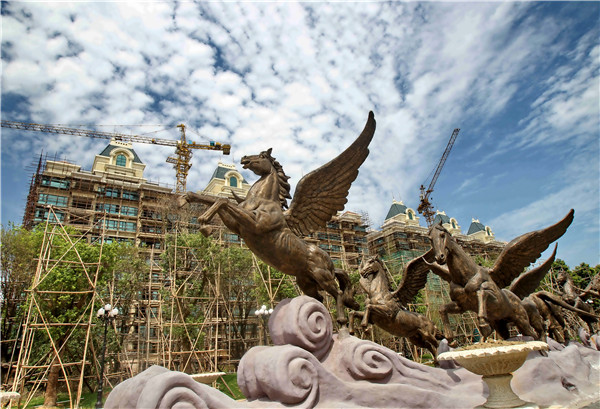Name-dropping is the order of the day
By Zhang Yi (China Daily) Updated: 2016-04-05 02:54
 |
|
"Venice", a residential compound in Qidong, Jiangsu province, seen during construction in September 2012. PROVIDED TO CHINA DAILY |
Western styles
The issue reflects the trend of imitating Western-style architecture and the pursuit of managed landscapes for living environments that accompanied China's urbanization boom. In recent years, high-end residential complexes constructed in European and other architectural styles have multiplied in cities and suburbs across the country.
For example, "Thames Town" in Shanghai is an English-themed residential compound about 30 kilometers from the city's downtown. Built in 2005 and designed by Atkins, a global engineering consultancy headquartered in the United Kingdom, the luxury residential area is home to accurate replicas of Tudor frontages, cobbled streets and Edwardian townhouses.
The compound, in the city's Songjiang district, was part of a project by the Shanghai municipal government to re-house 500,000 people in nine new satellite towns, each built in a different style. Other Western-themed developments have also been built in Shanghai's suburbs, including "Holland Town" and others in the styles of Italian, Canadian and Scandinavian architecture.
Although the practice may seem harmless, critics argue that some names are ridiculously exaggerated and may even be designed to deceive home buyers. In Zhengzhou, for example, "Vienna Woods" consists of just a couple of trees and "Venice Watertown" is a small pond.
Commentators on social media platforms are divided over the issue. Some have pointed out that residential buildings are part of geographical locations, so the names of the buildings should adhere to national standards, while others believe that real estate companies should be allowed to call the buildings they have developed by whatever name they choose.
"The naming of residential buildings should be in line with the rules set forth by the State Council, as well as bylaws issued by the Ministry of Civil Affairs," said Liu Lian'an, a professor at the China Institute of Toponymy (the study of place names).
The Regulation on Geographical Names, published by the State Council and enacted in 1986, and subsequent bylaws issued in 1996 stipulate that residential compounds, individual buildings and apartment units are subject to the rules outlined in the guidelines.
A clause in the bylaws states that "names of foreign persons and foreign geographical features are not allowed to be used for geographical names in China".
According to Liu, some long-standing place names have disappeared completely because the ancient buildings after which they were named have either been knocked down or were damaged beyond repair. Many were also changed after the original buildings were replaced by new ones and the locations were renamed after the new constructions.
He added that the unusual names given to places and buildings reflect an appreciation of foreign culture and an admiration of foreign lifestyles, which indicates a lack of confidence in traditional Chinese culture. The pursuit of commercial benefits via the use of exotic names has also resulted in people associating some public places with foreign cultures.
That view was echoed by Wu Yutian, a 35-year-old Zhengzhou resident: "In China, a country with more than 5,000 years of civilization, a name of a geographical feature usually carries a significant historical meaning. For example, Erqi Tower, in the center of Erqi square in the downtown, was built to honor 27 workers who died in a general strike in 1923. Now, the tower is dwarfed by skyscrapers, but I don't think the names of the tower and the square should be changed to fit the surrounding new buildings because the story behind the name would probably be unknown to future generations."
One resident, who preferred not to be named, said: "Zhengzhou is a major birthplace of ancient Chinese culture, and many tourists from home and abroad come here to look at relics dating back for millennia. The value of these relics can be compared with the Terracotta Warriors in Xi'an. Local governments have an obligation to protect existing names of geographical features, and protect the city's history and culture."
Liu, from the Institute of Toponymy, explained the approval procedure. He said a construction plan containing the proposed names of buildings is usually submitted to a civic planning committee, while in some places local civil affairs departments, which are responsible for overseeing place names, are not involved, but individual officers are often asked for their personal opinions.
The March meeting on standardizing place names also debated the renaming of localities, which are often associated with geographical features or have an approximate cultural meaning. For example, Beijing literally means "North Capital", while Shanghai can be translated as "the place to set out to sea".
Li, the minister, stressed that geographical names carry a country's culture, history and national spirit. "We must put an end to the capricious renaming of geographical locations and prevent the disapp-earance of names with historical and cultural meanings," he said.
The recent renaming of a road in Zhengzhou proved so controversial that it attracted the attention of the public nationwide. The local government changed the name of Zhacheng Road to Ping'an Road, but the move was so unpopular that in September, five residents filed a lawsuit against the government to reverse the decision.
The city government claimed that the new name, which literally translates as "Peace Road", will be more easily recognizable to people from other areas, and that the change was supported by the results of a poll conducted among local residents.
According to one of the plaintiffs, Zhu Guangyi, whose family has lived in the city for at least 430 years, "Zhacheng" was the name of a country that existed in the area about 3,500 years ago.
At the court hearing in February, the 60-something said the government's move violated the State Council's regulations on changes to the names of geographical locations and also the guideline that states that names with significant historical meanings should be protected. The court has not yet announced a ruling on the case.
- Once-endangered pony makes comeback
- Xi's meeting with Obama 'eases tensions'
- Signs in Chinese would help France attract more visitors
- Bookshop worms way into community
- Chinese eye eco-burials as graveyards fill up
- Shenzhen's clampdown on e-bike hits courier services
- Holiday upsurge leads to record-breaking box-office revenues in 1Q
- Fire kills three, injures 21 in South China
- New laws aim at ensuring nuclear safety
- China assumes rotating presidency of the UN Security Council for April








